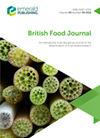Seaweed as food: survey of the UK market and appraisal of opportunities and risks in the context of iodine nutrition
IF 3.4
3区 经济学
Q1 AGRICULTURAL ECONOMICS & POLICY
引用次数: 1
Abstract
Purpose Seaweeds are gaining broader interest in Western societies through their use in product development and the health-food industry. High nutritional value, low carbon footprint and sustainability are key drivers for seaweed uptake in Europe; yet high iodine intake from seaweed remains a concern. This study seeks to identify seaweed food products available on the UK retail market between 2018 and 2021 and assess their safety in the context of iodine exposure.Design/methodology/approach Here, a market survey (n = 37–40 retailers) was conducted in three annual waves to evaluate seaweed food product availability in the UK. The iodine dose of products was estimated based on a comprehensive literature review of seaweed iodine content.Findings This study shows a young, dynamic market with 2.3-fold increase in seaweed food product availability since the last available published data (2015). Specific iodine content labelling remains uncommon, and median iodine doses in a single serving of food exceeded 400 µg in all years. Some products, especially seaweed supplements, provide iodine doses above the tolerable upper limit and upper level of tolerance.Originality/value This study presents the most contemporary and comprehensive overview of the market for seaweed food products in the UK. With increasing popularisation of seaweed as a food, this study highlights the need for improved dialogue amongst producers, retailers, legislators and public health specialists to address the risk of iodine excess, and the concurrent scope for processing methods to reduce the iodine content in seaweeds.海藻作为食物:英国市场调查和碘营养背景下的机会和风险评估
目的海藻通过在产品开发和保健食品行业的应用,在西方社会获得了更广泛的兴趣。高营养价值、低碳足迹和可持续性是欧洲海藻吸收的关键驱动因素;然而,海藻中的高碘摄入仍然令人担忧。这项研究旨在确定2018年至2021年间英国零售市场上可用的海藻食品,并在碘暴露的背景下评估其安全性。设计/方法/方法在这里,分三年进行一次市场调查(n=37-40家零售商),以评估英国海藻食品的可用性。产品的碘剂量是根据海藻碘含量的全面文献综述估计的。研究结果这项研究显示了一个年轻、充满活力的市场,自上次公布数据(2015年)以来,海藻食品的供应量增加了2.3倍。特定的碘含量标签仍然不常见,单份食物中的碘剂量中位数在所有年份都超过了400微克。一些产品,尤其是海藻补充剂,提供的碘剂量超过了可耐受的上限和耐受的上限。独创性/价值这项研究对英国海藻食品市场进行了最现代、最全面的概述。随着海藻作为一种食品的日益普及,这项研究强调了生产商、零售商、立法者和公共卫生专家之间加强对话的必要性,以解决碘过量的风险,以及降低海藻中碘含量的加工方法的同时范围。
本文章由计算机程序翻译,如有差异,请以英文原文为准。
求助全文
约1分钟内获得全文
求助全文
来源期刊

British Food Journal
工程技术-食品科技
CiteScore
6.90
自引率
15.20%
发文量
219
审稿时长
18-36 weeks
期刊介绍:
After 115 years, the British Food Journal (BFJ) continues to be highly respected worldwide for its broad and unique interdisciplinary coverage of the latest food-related double blind peer-reviewed research. It links all sectors of this dynamic industry, keeping abreast of emerging trends, topical and controversial issues and informing and stimulating debate. - See more at: http://emeraldgrouppublishing.com/products/journals/journals.htm?id=bfj#sthash.O3wH4pEh.dpuf
 求助内容:
求助内容: 应助结果提醒方式:
应助结果提醒方式:


